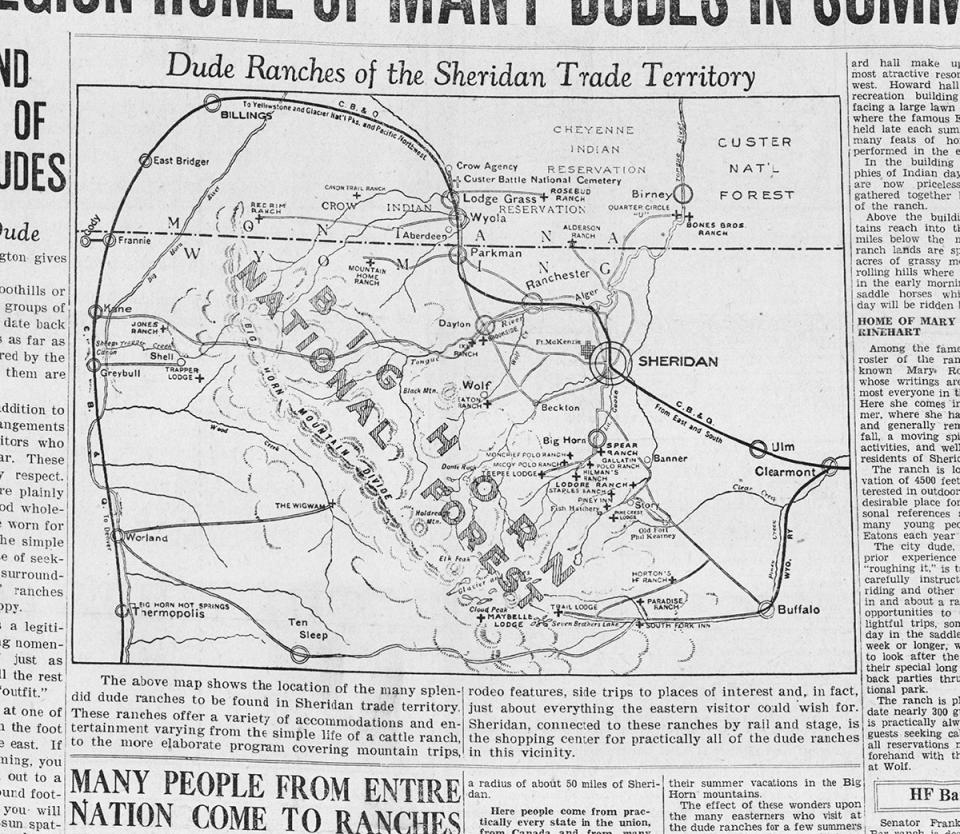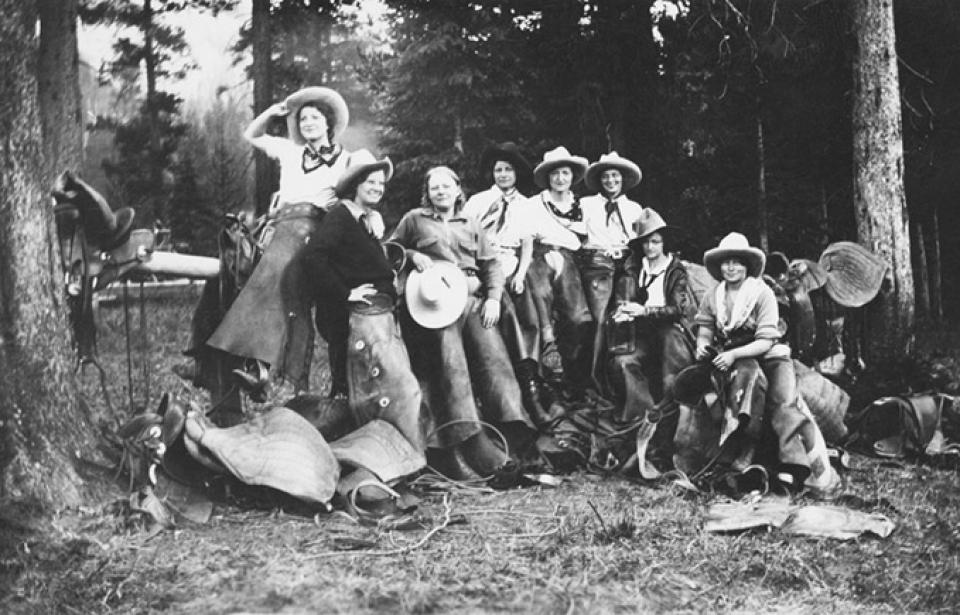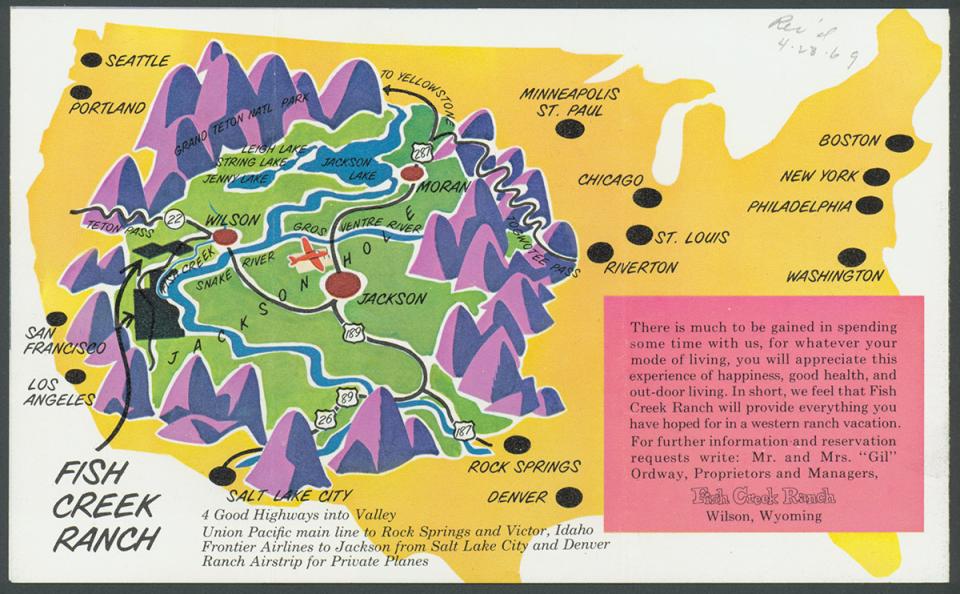- Home
- Encyclopedia
- Romancing The West: Dude Ranching In Wyoming
Romancing the West: Dude Ranching in Wyoming
Dude ranches sometimes get short shrift in history because they’re seen as contrived, Hollywood-derived entertainment, distant from the real work of Wyoming’s agricultural and resource-based industries. In its 1920s heyday, however, dude ranching was a common and respected way for elite Americans to experience the West. The fact that many did so in Wyoming not only bolstered the regional economy and culture, but also shaped national ideas about Western identity.
In many ways, dude ranching emerged as an extension of guiding. As Euro-Americans explored the West, they often hired experts to help. After President Theodore Roosevelt took office in 1901, his earlier, much-touted experience on a North Dakota cattle ranch often led visitors’ interest in hunting and sightseeing to merge with interest in ranch lifestyles.
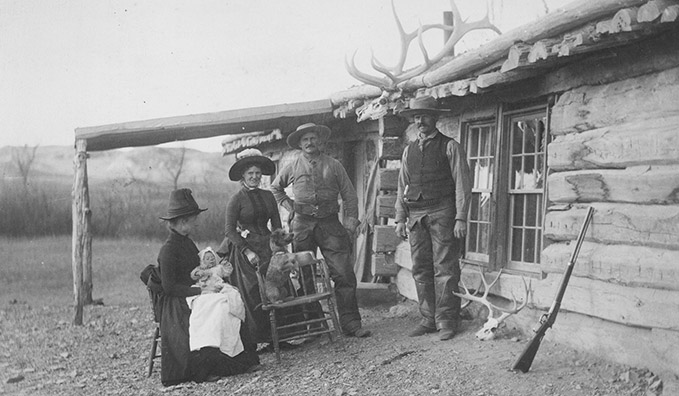
The first dude ranch
Howard, Alden and Willis Eaton—brothers from a prominent Pittsburgh family—are widely credited with running the first dude ranch. Howard established a ranch near Medora, Dakota Territory, in 1879, with his brothers soon following. After the Northern Pacific railroad arrived the following year, they frequently had guests from back east. In 1882, one guest, Bert Rumsey, insisted on paying Howard for his troubles. By the following year, the Eatons had so many paying guests that Howard started taking them on pack trips where they toured Yellowstone National Park.
Howard is also credited with first applying the word “dude” to his guests. In the 1880s dude was popular urban slang for a dandy or a fop--an overdressed, often stupid character. In the early days, the Eatons often hosted restless teenage boys for escapades of hunting, range riding and roundups. According to Tom Ringley’s history of the Eatons, the staff was amused at the boys’ affection for accouterments such as immense hats, big revolvers, rattlesnake belts and leather chaps. The boys dressed colorfully—far more “cowboy” than any cattle tender did. Perhaps the boys’ overdressing helped give name to an entire class of tourists and the industry that served them.
Whatever its source, “dude” was soon scrubbed of any connotations with stupidity. A dude was simply any tourist staying on a dude ranch. Dude ranchers insisted that this indicated a monetary relationship rather than a skill differential—a dude was not necessarily a tenderfoot and indeed, might be an accomplished rider, but was not a full-time resident.
Image
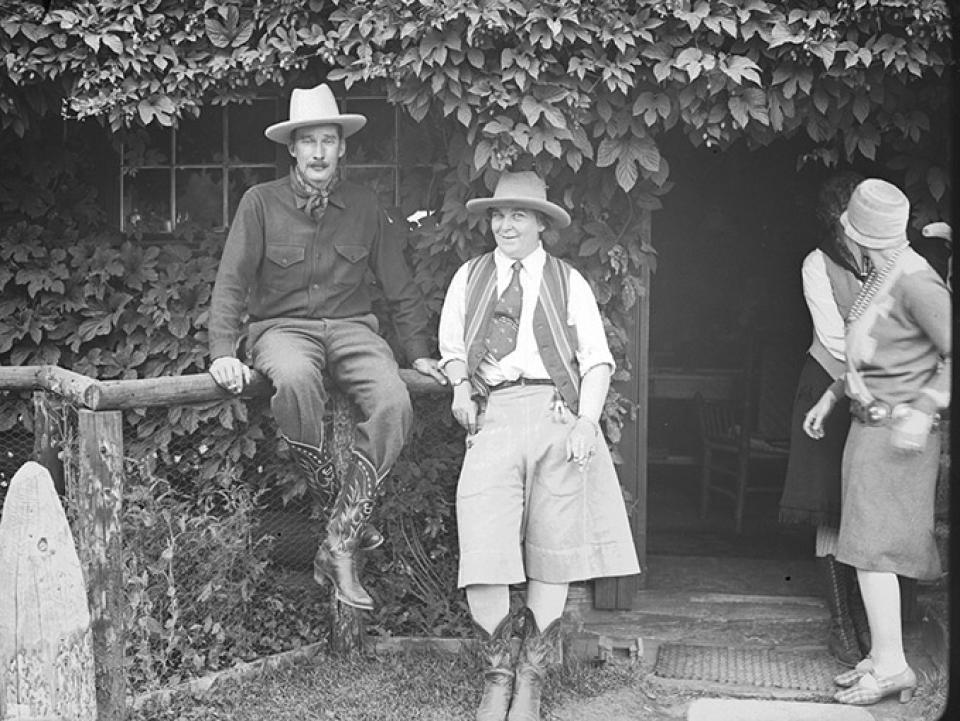
In 1904, the Eatons moved their ranch to Wolf, Wyo., west of Sheridan. Although their motives are not recorded, it’s likely they saw that dudes enjoyed more unspoiled territory, with mountain scenery, fishing, hunting and large expanses of public land in that part of the West.
More Wyoming dude ranches
Around this time, many other dude ranches opened in locations that were close both to railroads and to Yellowstone or other wilderness areas for backcountry pack trips. Within a decade, the east slopes of the Bighorns also included the IXL near Dayton, the HF Bar at Saddlestring, Trail Lodge and the Paradise Ranch in the Bighorns above Buffalo and the Tepee Lodge in the mountains above the town of Big Horn.
In 1898, Aron “Tex” Holm constructed a lodge on the North Fork of the Shoshone River west of Cody, Wyo., rebuilding it in 1910 to complement his business taking tourists on camping trips through Yellowstone. Other guides—including Sam Aldrich, Ned Frost, Fred Richard, Joe Jones and William F. “Buffalo Bill” Cody, for whom the town was named—also had area ranch headquarters with buildings where guests stayed. Some of these would evolve into dude ranches.
The concept of a dude ranch as distinct from a hunting camp or lodge owed much to I.F. “Larry” Larom, who first visited the South Fork of the Shoshone as a 21-year-old Princeton student in 1910. Five years later he bought the Valley Ranch on the South Fork with his friend Winthrop Brooks, whose family owned Brooks Brothers clothiers in New York. Larom’s great innovation was to transform boardinghouse-style accommodations into those of sufficient luxury to attract upper-class guests, especially women.
In the Jackson Hole area, M. Struthers Burt achieved similar aims. Burt entered a partnership with Louis Joy at the JY, which Joy had opened in 1908 as the first dude ranch in Jackson Hole. In 1912, Burt and Horace Carncross established the Bar BC, consciously striving to attract guests who shared their upper-class Philadelphia background. Later Jackson Hole dude ranches included the White Grass, the Danny Ranch, the STS, the Half Moon, the Trail Ranch, the Double Diamond, the Castle Rock, the Circle H, the Flying V, the Red Rock, the V Bar V, the Triangle X, the Gros Ventre and the Warbonnet.
The Jackson Hole, greater Cody, and Sheridan/Buffalo areas thus emerged as the first dude ranching centers, along with Montana (especially areas north of Yellowstone) and scattered areas in Colorado. New establishments opened in clusters, often run by former dudes or employees of nearby ranches. Individual dude ranches also thrived in other scenic areas, such as Henry Seipt’s The Hermitage (later the T Cross) and Charles Moore’s CM Ranch, both near Dubois; Watson and Gay Wyman’s Trapper’s Lodge near Shell; the Medicine Bow Lodge near Saratoga and the A Bar A near Encampment.
Guests by referral
Because dude ranchers could most easily attract people they knew, ranches tended to draw from specific geographic areas, especially in early days. For example, the Eatons drew from Pittsburgh, Larom from New York and Burt from Philadelphia. Furthermore, each had an associated celebrity: the Eatons had known Theodore Roosevelt in North Dakota; the Cody area ranches capitalized on Buffalo Bill and the Jackson area ranches focused on Owen Wister, author of The Virginian. Wister, a great traveler, visited ranches in many parts of Wyoming, but in 1912 built a summer home near the JY.
Dude ranchers usually traveled to the East during the late winter to market their businesses; for years Larom maintained an office in the Brooks Brothers building in New York. The marketing was personal because dude ranching was a referral business in which prospective guests had to provide references. As was common in many elite institutions of the time, Jews and African-Americans found their applications denied.
Dude ranching’s popularity
Dude ranches achieved their greatest power and influence during the 1920s. This was both encouraged and reflected in popular culture of the time. Acclaimed author Mary Roberts Rinehart helped popularize the dude ranch with her 1916 travelogue Through Glacier Park: Seeing America First with Howard Eaton.
In 1922, photographer Charles Belden inherited co-ownership of the Pitchfork Ranch near Meeteetse. Belden’s work in newspapers and in National Geographic provided romantic visuals for the dude ranching lifestyle. To a lesser extent, so did other artists, such as painter Joe DeYong, who was associated with the Eatons’ Ranch.
Cody newspaperwoman Caroline Lockhart’s best-selling 1921 novel, The Dude Wrangler, put a comic spin on the industry’s productive class tensions. And Struthers Burt’s 1924 memoir, Diary of a Dude Wrangler, extolled and explained the phenomenon from the inside.
Activities varied by ranch, but most centered on horses. Dudes could go on short rides or longer pack trips. They might also fish, swim, hike or attend local rodeos. Larom was a co-founder of the Cody Stampede, and the Eatons were major figures behind the Sheridan-Wyo-Rodeo.
The atmosphere was decidedly informal, which was a particular drawing point in that era. Many East Coast resorts had become stuffy and socially constricted; in the West, the dude ranch promoters suggested, you could relax and be yourself. Many dudes took advantage by donning flamboyant versions of cowboy clothing. Struthers Burt wrote that the dude rancher “knows that when Eastern damsels put on overalls and wear egregious scarfs they don’t look in the least like cowgirls, but he encourages them to do these things because it is good for their souls.”
Dude ranch staff
This negotiating of eastern and western desires and traditions put the staff of a dude ranch in a unique class position. Although dependent on their wealthy guests for paychecks, they possessed western skills that the guests envied and desired. Furthermore, by catering to return customers, many dude ranches came to resemble families. For example, Howard and Willis Eaton, who never had families of their own, were widely known as “Uncle Howard” and “Uncle Willis.” Upon their deaths, in 1922 and 1929 respectively, they were widely mourned.
They were popular figures because their hospitality was genuine. Successful dude ranchers loved being with people and creating a positive, productive atmosphere that made dudes feel like more than guests. Indeed, Larom boasted that he was never sued and didn’t even give a thought to buying liability insurance until 1949.
Skill versus appearances
Because the dude ranch was packaging Western experiences for Eastern audiences, Burt believed that Easterners needed ownership stakes. “I know of but one or two successful dude ranches in which there is not one Easterner at least who is a very important spoke in the wheel, for with all his virtues, the native son does not as a rule know what an Easterner or Middle Westerner wants, or why he wants it.” Such a middleman role made the dude rancher an ultimate example of what historian Hal Rothman called the “neonative,” perceived by outsiders as native to the area, but never truly possessing the skills or attitudes of the genuine locals.
This outsider status may have contributed to derision from cattle and sheep ranchers. A dude ranch’s value was not related to the production value of its pastures but instead to scenery and customer service. Dude ranches didn’t need to make money from livestock; they needed only enough livestock to give dudes the sense of being on a ranch. Their challenges thus differed from those of many Wyomingites of the time.
Dude ranch difficulties
But there were challenges. In 1923, a temporarily despondent Larom wrote to his silent partner Brooks that after nine years he was still making less money than his cooks. “Every day requires more work, more planning, more direction, more desk work. . . .The glamour of the West and all that rot has long since faded away. My only pleasure is in making this company a success, not in my surroundings, nor in the gossiping trash we call neighbors, nor in the long winters, spring floods and summer cloudbursts. This is the toughest damn country to make a living in there is, and despite our temporary difficulties we are the only ones who are getting anywhere.” Larom’s mood and fortunes apparently improved later, as he continued successfully running the ranch for decades.
Dude Ranchers Association
Dude ranch owners had always worked closely with railroads, which distributed attractive brochures highlighting an area’s ranches as a way of increasing passenger traffic. In 1926, with the cooperation of railroads and national park officials, 26 ranches organized the Dude Ranchers Association. Membership expanded to 47 the following year, with Larom as president and Willis Eaton, Horace Carncross, and Ed Wyman of Trappers Lodge on the board of directors. The other two officers and the other four directors were Montanans.
In addition to cooperating on marketing and publicity, the group voted to work on the organized protection of fish and game. Thus dude ranchers were among the earliest Wyoming conservationists. Dudes marveled at wildlife, and so dude ranchers sought to preserve it. Burt and other Jackson dude ranchers also played a key role in establishing Grand Teton National Park.
Teenage boys were always key contributors to dude ranch incomes. In Dubois, Charles Moore started his outfit as an outdoor camp for boys and only after World War I expanded to families. In Cody, Larom started the Valley Ranch School in the 1920s to improve the returns on the investment by using his grounds all year.
Industry growth
By 1930, dude ranching was a prominent industry dominated by the 100-plus establishments in the state of Wyoming. There were 31 dude ranches in the Sheridan area and 21 in the Jackson area. As a percentage of total tourist traffic, dude ranches were never significant. But because they attracted elites, their influence exceeded their numbers. As noted above, writers and artists publicized the dude ranch and its values.
And economically, many dudes who embraced the lifestyle ended up purchasing their own part- or full-time cattle ranches. One great example is Haydie Yates, whose memoir 70 Miles from a Lemon chronicles her 1920s experiences on a ranch just across the Montana border from Sheridan.
Such investments are difficult to measure. However, Larom estimated, “In Wyoming alone the value of the former dude ranch guests’ investments exceeded ten million dollars in lands, livestock, and equipment.”
Many dude ranches suffered after the 1929 stock market crash. Easterners found that cutting out a dude ranch vacation was an easy way to economize. Some dude ranches went out of business, and those were often purchased as vacation homes by former dudes. However, others continued to succeed, and some cattle ranches started taking dudes for extra income.
The industry became so established in the state that in 1934, the University of Wyoming began offering a degree in recreational ranching, with training in institutional management, cuisine, animal production, zoology, geology, western lore, veterinary science and agronomy.
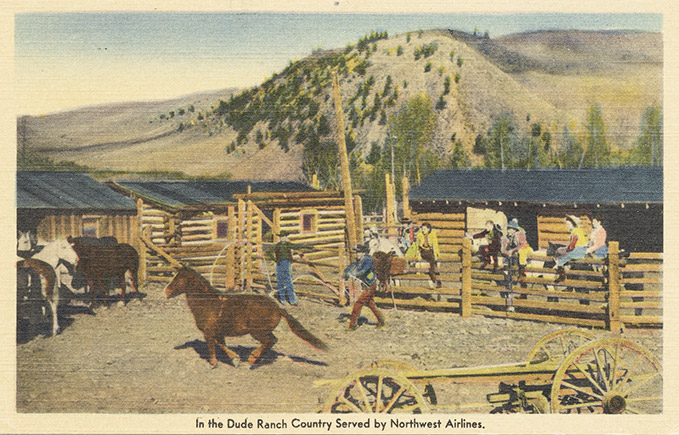
Modern-day dude ranching
However, the golden era of dude ranching was fading. As tourism rebounded after the Depression and World War II, vacations often took the form of shorter, more mobile automobile trips, rather than lengthy stays at a dude ranch.
Wyoming dude ranches also faced increasing competition. Dude ranches in Arizona, California and even Hawaii could replicate the informal horse-based atmosphere while offering a longer season of warm weather. In 1943, an Eastern Dude Ranchers Association was organized; its members rarely had cattle or the panoramic views available in Wyoming, but offered a getaway convenient to Eastern population centers.
Many dude ranches continue to operate successfully today; as of early 2014 the Wyoming Dude Ranchers Association lists 24 members. The industry’s significance, however, is tied to the changes in attitude reflected in the successes of its heyday. Before the dude ranch began, Wyoming was often seen as a place where a person might homestead a hardscrabble ranch or dig minerals from the ground.
But dude ranches showed off Wyoming’s mountain scenery, fishing and hunting, genial hospitality, and the informal, relaxed attitude gained from summer days spent outdoors. For elites of the day—and, thanks to their cultural taste-making, generations to follow—Wyoming and the West came to be associated less with cold or wind or distance and more with these romantic glories.
Resources
Primary Sources
- Burt, Maxwell Struthers. The Diary of a Dude-wrangler. New York: Scribner, 1924, 1938.
- Larom, I.H. “Larry.” “Dude Ranching in Wyoming,” In The Historical Encyclopedia of Wyoming. Vol. 1. Cheyenne, Wyo.: Wyoming Historical Institute, 1970, 90-93.
- Rinehart, Mary Roberts. Through Glacier Park: Seeing America First with Howard Eaton. Boston: Houghton Mifflin, 1916.
- Smelker, Renee Howard. The Bar BC Chronicle: Jackson Hole Dude and Cattle Ranching, 1922-1942. Anchorage, Alaska: West Rock Sagas, 2009. An oral history of the Bar BC Ranch in Jackson.
- Yates, Emma Hayden. 70 Miles from a Lemon. Boston: Houghton Mifflin, 1947.
Collections and archives
- The American Heritage Center at the University of Wyoming in Laramie contains several collections of primary source materials, including records of the Eatons’ Ranch, the Triangle X in Jackson and the Dude Ranchers Association; issues of “The Dude Rancher” newsletter; and papers and oral histories of other dude ranchers.
- The Buffalo Bill Center for the West in Cody includes the Charles Belden Collection of manuscripts and photographs and the Irving H. “Larry” Larom Collection, also including photos, some by Belden. The center’s research summary presents a statewide overview.
- The Park County Historical Archives in Cody has files on many area dude ranches, reprints of articles by dudes and a photo collection. Many other Wyoming historical organizations, such as the Jackson Hole Historical Society and Museum, have local photographs and materials. Dude ranchers and even dudes frequently appeared in newspaper stories. Search for their names at the Wyoming Newspaper Project.
Secondary Sources
- Borne, Lawrence R. Dude Ranching: A Complete History. University of New Mexico Press, 1983.
- ______________________. “Dude Ranching in the Rockies.” Montana: The Magazine of Western History, 38, no. 3 (Summer, 1988): 14-27.
- Daugherty, John, et al. A Place Called Jackson Hole: A Historic Resource Study of Grand Teton National Park. Moose: Grand Teton Natural History Association, 1999. Chapter 14: The Dude Wranglers.
- Edgar, Bob and Jack Turnell. Brand of a Legend. Cody, Wyo.: Stockade, 1978. Covers the Pitchfork Ranch near Meeteetse.
- Johnson, Adrienne Rose. “Romancing the Dude Ranch, 1926–1947.” The Western Historical Quarterly 43, no. 4 (Winter 2012): 437-461.
- Kensel, W. Hudson. Dude Ranching in Yellowstone Country: Larry Larom and Valley Ranch, 1915–1969. Norman, Okla.: Arthur H. Clark Co., 2010.
- Rees, Amanda. ““A Classless Society:” Dude Ranching in the Tetons 1908-1955.” Annals of Wyoming: The Wyoming History Journal. Autumn 2005, 2-21.
- Ringley, Tom. Wranglin’ Notes: A Chronicle of Eatons’ Ranch. Greybull, Wyo.: Pronghorn Press, 2012.
- Ringley, Tom. Saddlestring, A History of the HF Bar Ranch. Greybull, Wyo.: Pronghorn Press, 2006.
- Rodnitzky, Jerome L. “Recapturing the West: The Dude Ranch in American Life.” Arizona and the West, 10 no. 2 (Summer, 1968): 111-126.
- Rothman, Hal. Devils Bargains: Tourism in the Twentieth-Century American West. Lawrence, Kan.: University Press of Kansas, 1998, 120-142.
- Roundy, Charles G. “The Origins and Early Development of Dude Ranching in Wyoming,” 1970. Charles G. Roundy papers, American Heritage Center at the University of Wyoming in Laramie. Finder’s guide accessed Jan. 28, 2014 at http://rmoa.unm.edu/docviewer.php?docId=wyu-ah03550.xml.
For Further Reading and Research
- King, Bucky. The Dude Connection: A Brief History of Dude Ranching in Sheridan and Buffalo, Wyoming and Birney, Montana. Laramie, Wyo.: Jelm Mountain Press, 1983. Stories of four generations of family connections among dude ranch owners, wranglers and dudes along the east side of the Bighorn Mountains.
- Lockhart, Caroline. The Dude Wrangler. Garden City, NY: Doubleday, 1921. A comic novel set on a dude ranch, clearly based on the author’s friendships with many early Cody dude ranchers.
- Sandoval, Judith Hancock, T. A. Larson, and Robert A. Roripaugh. 1986. Historic ranches of Wyoming. Casper, Wyo: Nicolaysen Art Museum. Overview text, plus 96 handsome black-and-white photos of historic ranches and dude ranches, including the Valley, Pitchfork and others in this article, with descriptions and histories of each.
- Spragg, Mark. Where Rivers Change Direction. Salt Lake City: University of Utah Press, 1999. A compelling account of the author’s growing up in the 1950s and 1960s on the Crossed Sabres dude ranch—the former Holm Lodge on the North Fork of the Shoshone, west of Cody.
- Former Turpin Meadow Ranch owner Elaine Luton talks with current owner Nancy Johnstone in Turpin Meadow Then and Now, a film about dude ranching past and present by Jennifer Tennican. Turpin Meadow is at the northeast end of Jackson Hole. Luton owned the ranch from 1969 to 1993; Johnstone and her husband bought it in 2012. They talk about old and new ways of doing business, various celebrity guests, and making ends meet.
Field Trips
Many dude ranches are still in operation. To visit one, contact the Dude Ranchers’ Association, which is national in scope but based in Cody, or Wyoming Dude Ranchers Association, based in Kelly, Wyo. in Jackson Hole.
Illustrations
- The 1920 color postcard of Eatons’ Ranch and the map of Sheridan-area dude ranches from the Aug. 18, 1927 edition of the Sheridan Journal are from the collections of The Wyoming Room, Sheridan County Fulmer Public Library. Used with permission and thanks.
- All other images are from the collections at the American Heritage Center, University of Wyoming. Used with permission and thanks.
- The early photo of the Eaton brothers and their families is from the Howard Eaton photo file at the AHC. Left to right: Mary Brown (Mrs. Alden) Eaton, baby Bill Eaton, Hattie Eaton, Howard Eaton and Alden Eaton.
- The Eatons’ Ranch brochure is from the Eaton Ranch Records file, and the two photos of mounted dudes at Eatons’ are from the AHC’s Eaton Ranch file.
- The four photos of Larry Larom and guests on the Valley Ranch are from the AHC’s Charles Belden Collection. The photo of the “dude girls” and their gear is from the Karl C. Allen Collection. The color Northwest Airlines postcard of a wrangler roping a horse while dudes watch is from the AHC’s Dude Ranching photo file. The color map from a Fish Creek Ranch brochure is from the AHC’s Dude Ranchers Association Collection.

